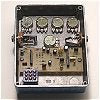Introduction: Simulated Woodgrain for Metal Boxes
This instructable shows how to prepare a metal box using a buffing technique that can simulate wood grain, birdseye or other finishes. The technique gives dimension to the box that adds visual depth to the surface.
It is easy to do and allows you to create a variety of nice finishes with little extra effort.
Step 1: Items Needed
The box that I am preparing is a small cast aluminum box that typically has a rough finish in the raw. This one is similar to the Hammond 1590B.
Every aluminum box should be sanded before painting to remove the oxidized aluminum from the surface so that the paint can adhere better to the base metal.
For this type of brushed or buffed finish, I am using an abrasive wheel that mounts in a hand drill.
The red and gray wheels are similar but the latter is a finer mesh that produces a smoother finish. The material seems to be some sort of tough nylon woven fiber much like the 3M abrasive pads that are commonly available.
I bought these buffing wheels in a kit at Harbor Freight.
Step 2: Buffing the Surface
They key to getting the grain lines and 3D effect is to use the buffing wheel at an angle.
Go over the entire surface of the box. Typically I start at one end and work my way to the bottom of the box face. Move the angled drill side-to-side and you will see a buffed and highlighted pattern emerge in the aluminum.
It is readily produced and if you make a mistake, all you have to do is buff over it to remove the error.
The sides of the box can be flat sanded or buffed with the abrasive disk to add some dimension.
Step 3: The Pattern Appears
After a few passes across the box, the pattern will begin to appear.
It is important to buff the entire surface of the box to remove the oxidation.
Usually, I do the edges before starting on the face or sides of the box.
Step 4: Wire Brushing
A soft brass brush can also be used to pattern the box surface but I find that it leaves too many scratches in the soft aluminum.
In this example, the top half of the box has been scarred with the brass brush and the bottom with the abrasive pad.
Step 5: Drilling Holes
Since this is a guitar effects pedal and requires holes for the controls and the audio jacks, I usually mark the holes and drill once the surface has been completed.
Here you see a template printed on clear mylar with the position of the various elements that are to be added during final construction.
Step 6: Closeup
The pilot holes are drilled and you can see some of the buffed pattern in the surface. Once the final holes are drilled, the box is ready for painting.
Step 7: Painting
For the wood grain finish that I am using on this box, two coats of paint are used.
Krylon X-Metals is a type of paint that remains transparent after drying and allows the look of the buffed surface to show through. It is available is several different colors and I bought that can at Hobby Lobby ($5.97).
After the clear yellow layer has dried sufficiently, I spray the box with a red transparent paint. In this case it is Duplicolor Metalcast red which came from an auto parts store, as shown in the second photo.
A second layer of red was applied to darken the finish and remove some of the orange cast. A rich mahogany-like surface will be revealed.
Step 8: Final Boxes
Other paint colors and buffing patterns can be used on the box surfaces. These were sprayed with Duplicolor Metalcast green only. Testors also offers some spray paints that are available in transparent colors.
The box on the left has a birdseye pattern made by moving the buffing pad in small circles as it is worked across the surface. In this case, I flat-sanded the surface of the box before coming back to add the pattern.
The box on the right was buffed in two passes, each only going to the centerline of the box. This produces a bookmatched imitation.
The surfaces are hard to photograph and capture the 3D effect produced.
Try some different buffing patterns and paints for an unusual custom finish!
More free DIY info is available on my web site: http://www.muzique.com/
First Prize in the
The Instructables Book Contest










